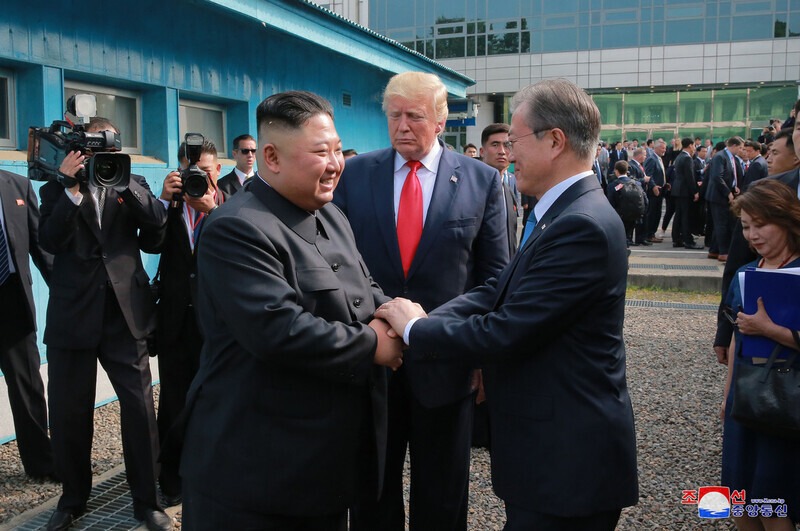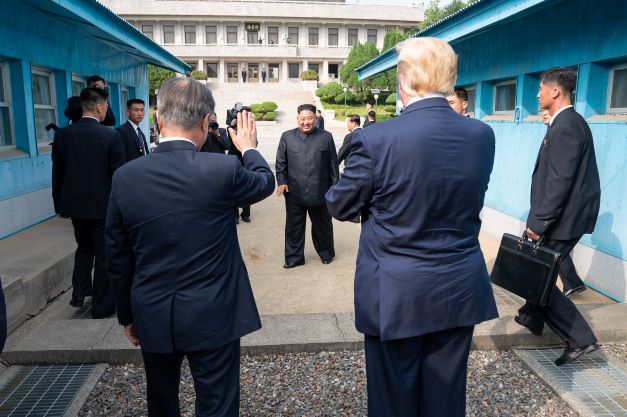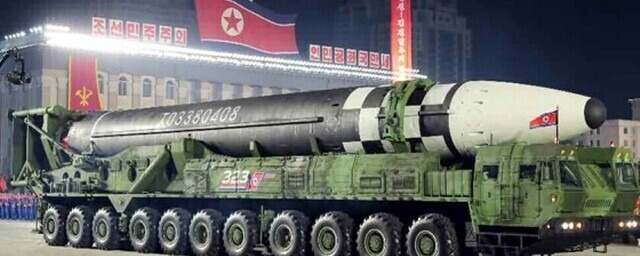Today’s Balance of Terror Between US, NK More Unstable Than Cold War
HANKYOREH
APLN member Cheong Wook-Sik points out that the balance of terror on the Korean Peninsula is very unstable due to a lack of suitable communication channels and an abundance of bluster. Read the original article here.
The Korean Peninsula has entered a nuclear era, but certain factors that were crucial for preventing nukes from being used during the Cold War are nowhere to be found in Korea.
Is a “balance of terror” scenario a possibility for the Korean Peninsula? It’s a question that arises when we look at the way the peninsula seems to be sliding irreversibly into a nuclear era.
A popular phrase during the Cold War between the US and Soviet Union, the “balance of terror” amounts to a minimum appeal to human self-preservation instincts and reason — the idea that both sides should refrain from any foolish actions that would get everybody killed.
In practice, this was a precarious approach. This is why some people refer to the Cold War era as a “long peace.”
But what about a place like the Korean Peninsula, where US nuclear weapons are sharply pitted against North Korean ones? Before considering an answer, we should first examine why the peninsula is seen as having entered an irreversible “nuclear era.”
Decisive no-deal summit in Hanoi
Since the Korean War, the US’ nuclear threat toward North Korea has been a constant: continuous, planned and reiterated. The variable was whether North Korea would acquire its own nuclear arsenal.
But the conclusion that North Korea reached during the talks in 2018-2019 — and more broadly, over the past three decades — is that dialogue and negotiations are pointless.
In connection with that, it’s very important to recognize that North Korea has fundamentally changed since the summer of 2019. For nearly the three decades prior to that, Pyongyang’s key goal was normalizing relations with the US.
But then the North Korea-US summit in Hanoi, in February 2019, ended without a deal, torpedoing the outcome of the South-North-US summit in Panmunjom on June 30 of the previous year. That was the point when North Korea’s strategy underwent a fundamental change.
Since then, Pyongyang has almost entirely given up its desire to normalize relations with the US and has been clearly signaling that it intends to reorient its security on nuclear weapons, its economy on autarky, and its foreign policy on China and Russia.
And North Korea has been making considerable progress toward those ends. The advancement of its nuclear program is widely acknowledged, and contrary to assessments from the outside, it’s likely that the North Korean economy has been steadily improving.
Whereas North Korea’s nuclear program used to be an obstacle in its relationships with China and Russia, those relationships have recently been at their strongest since the 1990s despite Pyongyang’s nuclear development drive.
A new constant in the equation
At the heart of that is the nuclear program on which North Korea has staked its national pride. The Pyongyang regime under Kim Jong-un believes that its nuclear program will not only reinforce national security but also contribute to economic development by enabling spending cuts on conventional weapons and promoting a shift from the military to the civilian economy.
Kim is confident that North Korea can gain strategic status if its nuclear arsenal serves as a “deterrent” against the hostile states of South Korea, the US and Japan and an “independent weapon” for the friendly states of China and Russia.
That process culminated in the adoption of a law about North Korea’s nuclear policy by the Supreme People’s Assembly on Sept. 8. Kim declared on that occasion that defining nuclear policy in law had “made our state’s status as a nuclear weapon state irreversible.” In short, North Korea’s nuclear weapons have become another constant.
The conditions for using nuclear weapons that North Korea laid out in this law are themselves very aggressive. While the authority to use nuclear weapons is reserved for Kim himself, the condition for such use is stipulated as cases in which a nuclear or non-nuclear attack on the state leadership or the state nuclear command apparatus by hostile forces has been carried out or is judged to be imminent.
Significantly, the law emphasizes that if an accident befalls Kim, as the person with the authority to order the use of nuclear weapons, “a nuclear strike shall be launched automatically and immediately to destroy hostile forces including the starting point of provocation and the command according to operational plans decided in advance.”
That provision seems largely aimed at forestalling a “decapitation operation” by the South Korea-US alliance, which has threatened to “prevent a nuclear strike by eliminating the person capable of authorizing one if there are indications that North Korea will use a nuclear weapon.”
The North’s new law also provides the following conditions under which nuclear weapons can be used: when a nuclear attack or an attack by another weapon of mass destruction has been carried out or is judged to be imminent, when major strategic assets of the state have suffered a devastating military attack or when such an attack is judged to be imminent, when there is an unavoidable operational need during a crisis to prevent the escalation or prolongation of war and to seize the initiative in the war, or when there is no choice but to respond with nuclear weapons following the occurrence of a crisis with devastating consequences for the survival of the state or the lives and safety of the people.
Rather than focusing the mission of the nuclear arsenal on deterrence, therefore, the law stipulates that a preemptive strike can be launched when a major attack from the outside is believed to be imminent. That said, this doctrine is similar to those of most nuclear weapon states except for China, which has disavowed the preemptive use of nuclear weapons.
There’s another point that merits our attention. North Korea has been regarded as one of the world’s most closed-off countries, but at least in regard to its nuclear policy, Pyongyang has staked out the most specific and concrete stance of all.
That becomes apparent in comparison with the US government under President Joe Biden. Even though the Biden administration finished composing its nuclear posture review in March 2022, it has only released a one-page summary and has kept mum about the details.
In contrast with that, North Korea has released a detailed list of the mission of its nuclear forces and the conditions of their use.
Why would that be?
That reflects North Korea’s desire to compensate for its inadequate military capabilities by flaunting its willingness to use nuclear weapons, so as to strengthen its war deterrence.
In response to this, South Korea and the US have also been cranking up their own threats against the North, such as in the joint statement published following a meeting of the high-level Extended Deterrence Strategy and Consultation Group on Sept. 16.
“The United States and the ROK (that is, South Korea) expressed their serious concern over the DPRK’s (that is, North Korea’s) escalatory and destabilizing messaging related to nuclear weapons use, including its adoption of the new nuclear policy law,” the statement said. “The United States and the ROK made clear that any DPRK nuclear attack would be met with an overwhelming and decisive response.”
In the same statement, the US also committed “to draw on the full range of its military capabilities, including nuclear, conventional, missile defense, and other advanced non-nuclear capabilities, to provide extended deterrence.”
As if to demonstrate that commitment, strategic assets including nuclear-powered aircraft carriers and strategic bombers have been appearing more frequently on and around the Korean Peninsula.
Balance of terror
That brings us back to our first question. Is the doctrine of war deterrence — based on the balance of terror — credible on the Korean Peninsula?
In short, that equilibrium is likely to be more precarious than it was during the Cold War between the US and the Soviet Union.
As is implied by the term “intercontinental ballistic missile,” the US and the Soviet Union had 5,500 km between them, whereas the South Korea-US alliance and North Korea are only divided by the armistice line.
During the Cold War, there was the Anti-Ballistic Missile Treaty, which aided “international peace and strategic security” by effectively banning missile defense systems. But around the Korean Peninsula, the countries of South Korea, the US and Japan are gradually expanding their missile defense systems.
If the South Korea-US alliance’s surveillance of North Korea can be compared to high-powered binoculars, it’s little exaggeration to say that North Korea’s surveillance and reconnaissance capabilities are comparable to a blindfold.
One lesson of the Cold War era is that even the most advanced intelligence assets are vulnerable to human misjudgments and misunderstandings, not to mention mechanical malfunctions that can potentially lead to nuclear war. But given North Korea’s severely backward intelligence capability, how could it judge that a major attack from the outside is imminent?
Comparing the situation during the Cold War with that on the Korean Peninsula today reveals another major difference. The US and the Soviet Union normalized relations in 1933, and the two countries continued to exchange ambassadors during the Cold War and even after Russia took over from the Soviet Union.
The two sides also maintained a hotline. That kind of communication was instrumental in preventing various crises — including the Cuban missile crisis in 1962 — from escalating into nuclear war.
Compared to that, there are no channels of communication worth mentioning between the South Korea-US alliance and North Korea. North Korea and the US have never normalized their relations during the 74 years since the regime was established in Pyongyang, and inter-Korean relations continue to worsen.
The reality on the Korean Peninsula is that a lack of suitable communication channels that could prevent a crisis from escalating coincides with an abundance of bluster about eliminating the other side’s leaders at the drop of a hat.
Taking all these factors into account, the balance of terror on the Korean Peninsula is very unstable.
Our response could be based on a frank recognition of that instability. First off, it has become critical to head off the kind of minor clashes that could provoke a major war. That’s why it’s important for the South Korean government under President Yoon Suk-yeol to take off its partisan blinkers and declare its commitment to respecting and developing the Comprehensive Military Agreement (concluded on Sept. 19, 2019), as well as for North Korea to respond to those overtures.
There should also be a public discussion about making a treaty to prevent nuclear war on the Korean Peninsula. While that would involve the discomfort of acknowledging North Korea as a de facto nuclear weapon state, it would also meet an urgent need — helping to prevent nuclear war.




